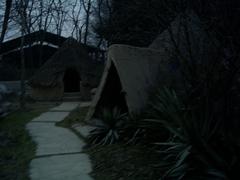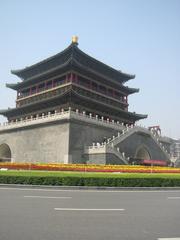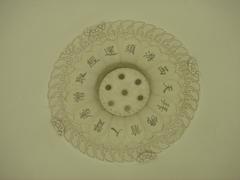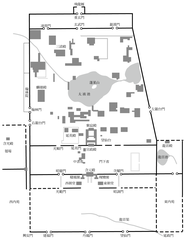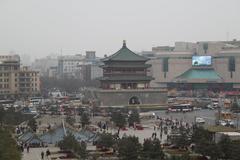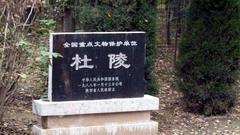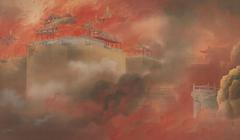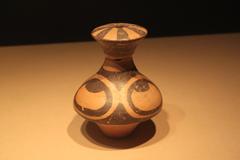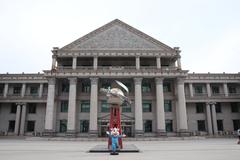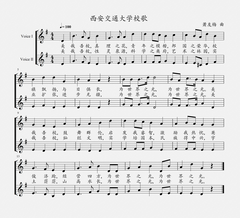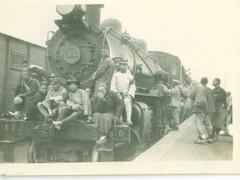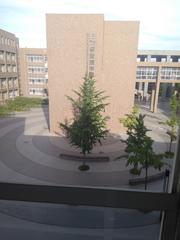Beida Jie Station Xi’an: Visiting Hours, Tickets, and Nearby Attractions Guide
Date: 04/07/2025
Introduction
Beida Jie Station (北大街站) is a central interchange in Xi’an’s metro network, connecting Lines 1 and 2 since its inauguration in 2011. As a strategic transport hub, it not only enables seamless travel across the city but also serves as a gateway to Xi’an’s renowned historical and cultural sites. Situated just north of the iconic Bell Tower, this station places visitors within reach of the Drum Tower, Muslim Quarter, and the ancient Ming Dynasty City Wall. Operating daily from 6:00 AM to 11:00 PM, Beida Jie Station offers a variety of ticket options, comprehensive accessibility features, and user-friendly bilingual services. Its location at the crossroads of the city’s heritage core and modern developments underscores Xi’an’s evolution from an ancient Silk Road capital to a bustling contemporary metropolis (Wikipedia, China Discovery, UrbanRail.net, TravelChinaGuide).
Table of Contents
- Introduction
- Origins and Development
- Visiting Hours & Ticket Information
- Station Facilities and Accessibility
- Travel Tips for Visitors
- Key Nearby Attractions
- Architectural and Archaeological Significance
- Special Events & Photographic Spots
- Socio-Cultural Importance
- Urban Integration & Economic Impact
- FAQs
- References & Resources
Origins and Development
Beida Jie Station opened on September 16, 2011, as Xi’an’s first interchange metro station, forming a pivotal point between Line 1 (east-west) and Line 2 (north-south) (Wikipedia). Its “+” configuration is characteristic of major Chinese urban metro planning, allowing efficient transfer and broad coverage of the city’s core districts (UrbanRail.net). The station’s construction was meticulously planned to safeguard nearby archaeological resources, especially the Ming Dynasty city wall and underground relics.
Visiting Hours & Ticket Information
- Operating Hours: 6:00 AM – 11:00 PM daily.
- Ticket Types: Single-ride tickets, day passes, and rechargeable metro cards (Xi’an Tong) are available. Tickets can be purchased at automated machines or counters with bilingual instructions.
- Fares: Start at CNY 2 for short trips, increasing by distance. One-day and three-day unlimited ride passes cost approximately CNY 15 and CNY 35, respectively.
- Discounts: Children, seniors, and disabled passengers receive reduced fares.
For current pricing and pass details, consult the official Xi’an Metro guide.
Station Facilities and Accessibility
Beida Jie Station is designed for convenience and inclusivity (Ruqin Travel):
- Elevators, ramps, and tactile paving for travelers with disabilities.
- Security checks and visible staff for safety.
- Restrooms, convenience stores, and ATMs in the main concourse.
- Bilingual signage (Chinese/English) and audible announcements for easy navigation.
- Multiple exits:
- Exit A: Bell/Drum Tower
- Exit B: Muslim Quarter
- Exits C/D: Hotels, banks, and bus stops
Travel Tips for Visitors
- Avoid peak hours (7:30–9:00 AM, 5:30–7:00 PM) to minimize crowds.
- Use translation apps and download the Xi’an metro map for smoother navigation.
- Keep valuables secure and be watchful in busy areas.
- Payment: Machines accept cash and major Chinese mobile payments (WeChat Pay, Alipay); international cards are rarely accepted.
Key Nearby Attractions
Bell Tower (钟楼)
- Distance: 10–15 minutes on foot from Exit A.
- Hours: Apr–Oct: 08:00–22:00; Nov–Mar: 08:00–18:00
- Ticket: CNY 30 (CNY 50 joint ticket with Drum Tower)
- Features: Ming-era architecture, panoramic city views, and musical performances. (China Highlights)
Drum Tower (鼓楼)
- Location: West of the Bell Tower, accessible via Zhonggulou Square.
- Hours: Similar to Bell Tower.
- Exhibits: Ancient drums, regular performances, and night illuminations.
Muslim Quarter (回民街)
- Access: Via Exit B; open 24/7, with shops/restaurants generally 08:00–21:00.
- Highlights: Famous street food (roujiamo, liangpi), vibrant markets, and the historic Great Mosque.
Xi’an Ancient City Wall (西安城墙)
- Access: Short walk or one stop east from Beida Jie.
- Hours: 08:00–22:00
- Ticket: CNY 54
- Tip: North Gate (Anyuanmen) is closest for entry; bicycle rentals available for exploring the wall.
Beilin Museum (Forest of Stone Steles)
- Hours: 09:00–17:30 (last admission 17:00)
- Ticket: CNY 10
- Collection: Over 3,000 stone steles, calligraphy, and historical records.
Great Mosque of Xi’an
- Hours: 08:00–21:00
- Ticket: CNY 45
- Features: Ancient Islamic architecture nested in the Muslim Quarter.
For further attraction details, see China Discovery’s Xi’an guide.
Architectural and Archaeological Significance
The station’s design blends modern infrastructure with motifs inspired by traditional city gates. Advanced construction methods, such as vibration-dampening technology, were used to protect the Ming Dynasty city wall and subterranean relics, demonstrating Xi’an’s commitment to heritage preservation alongside urban development (UrbanRail.net).
Special Events & Photographic Spots
The area around Beida Jie Station hosts cultural events and festivals, particularly during Chinese New Year and Mid-Autumn Festival. The Bell and Drum Towers, especially at night, provide excellent photo opportunities. The Muslim Quarter’s bustling alleys and street food stalls offer vibrant scenes for photography.
Socio-Cultural Importance
Beida Jie is at the intersection of Han Chinese and Hui Muslim communities. This cultural confluence is evident in the local cuisine, religious sites, and markets, reflecting Xi’an’s Silk Road heritage and vibrant urban life (Chinatripedia). The metro station’s presence has revitalized the surrounding districts, fostering economic growth and cultural integration.
Urban Integration & Economic Impact
The establishment of Beida Jie Station has spurred urban regeneration, increased property values, and supported local business development (ScienceDirect). Its integration with city buses and taxis, as well as proximity to hotels and commercial zones, enhances both resident and tourist mobility. As a model of sustainable urban planning, the station contributes to Xi’an’s low-carbon initiatives and balanced growth (The China Journey).
Frequently Asked Questions (FAQ)
Q: What are Beida Jie Station’s operating hours?
A: 6:00 AM to 11:00 PM daily.
Q: How can I purchase tickets?
A: At automated machines or ticket counters; options include single-ride, day, and multi-day passes.
Q: Is the station accessible for people with disabilities?
A: Yes, with elevators, ramps, tactile paving, and accessible restrooms.
Q: Which attractions are easily reached from Beida Jie Station?
A: Bell Tower, Drum Tower, Muslim Quarter, City Wall, Great Mosque, and Beilin Museum.
Q: Are there guided tours starting from Beida Jie Station?
A: Yes, several operators offer walking tours of the historical core, often meeting near the Bell Tower or Muslim Quarter.
Visuals and Resources
- Interactive Xi’an Metro map
- Official Xi’an travel guide
- Suggested visuals: Images of Beida Jie Station entrance, ticketing machines, Bell Tower, Muslim Quarter street food, and city wall panoramas (with descriptive alt tags).
Conclusion
Beida Jie Station is far more than a metro hub—it is the ideal starting point for exploring Xi’an’s rich tapestry of history, culture, and modern vitality. With its comprehensive facilities, user-friendly services, and prime location, it ensures visitors have a seamless and rewarding urban experience. Whether you are a history enthusiast, cultural explorer, or daily commuter, understanding Beida Jie’s operations, nearby attractions, and travel tips will empower you to navigate Xi’an with confidence.
For real-time updates, offline metro maps, and guided tour options, download the Audiala app and follow our social media channels. Embark on your Xi’an adventure at Beida Jie Station—the perfect nexus of past and present.
References
- Wikipedia: Beida Jie Station
- UrbanRail.net: Xi’an Metro
- China Discovery: Xi’an Tourism Board
- Ruqin Travel: Xi’an Subway Guide
- China Highlights: Xi’an Attractions
- ScienceDirect: Sustainable Urban Mobility in Xi’an
- TravelChinaGuide: Metro Line 2
- The China Journey: Tourism and Urban Development
- Chinatripedia: Xi’an Cultural Legacy
